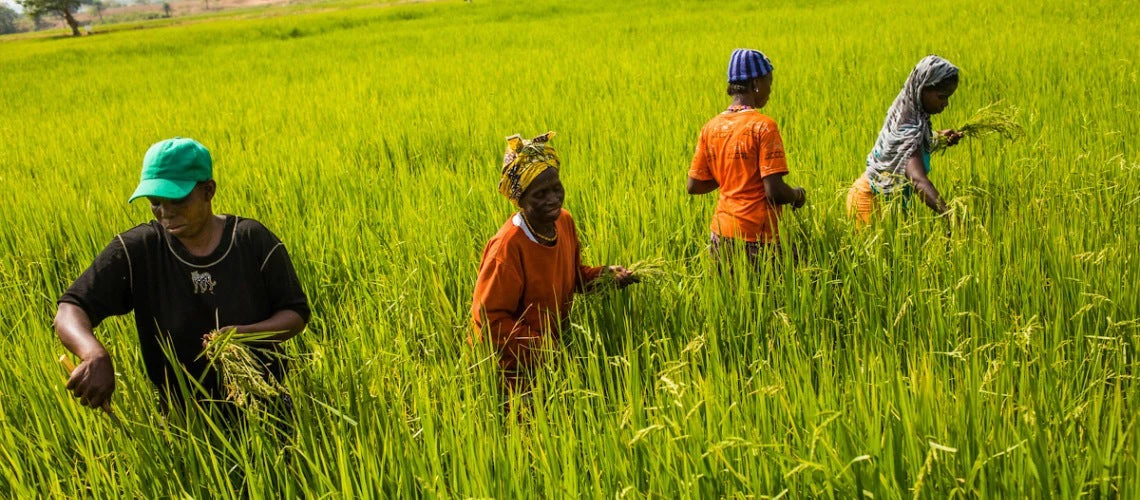 Climate change affects both existing and future jobs in sectors such as agriculture, construction, tourism, energy, and infrastructure. Copyright: Vincent Tremeau/World Bank
Climate change affects both existing and future jobs in sectors such as agriculture, construction, tourism, energy, and infrastructure. Copyright: Vincent Tremeau/World Bank
Climate change is one of the biggest risks to global development, as high temperatures, droughts, floods, and other extreme events destroy infrastructure, jobs, and livelihoods. Already, climate change costs the world $16 million per hour.
We can respond with increased and focused climate action, with recent studies projecting that climate mitigation and adaptation policies will improve overall job outcomes. In fact, these global simulations show overwhelmingly positive jobs impacts for green scenarios compared to business as usual.
How does climate change impact jobs?
Climate change affects both existing and future jobs in multiple ways that include reduced labor productivity, outputs, and incomes across diverse sectors such as agriculture, construction, tourism, energy, and infrastructure. The poor are the most vulnerable, often living in inadequate housing, working outside, and facing climate-related income losses with no means to adapt.
Projections of job losses under different climate change scenarios span a wide range but overall point to negative impacts. The ILO estimated the impacts of heat stress as a loss of two percent of total working hours worldwide by 2030 based on temperature projections, labor productivity measurements, and health records. Heat waves also impact tourism, leading to large decreases of often informal jobs. Agricultural yield models have projected losses of up to 10 percent per degree of global warming for certain crops, which can quickly turn into a tipping point and drive farmers out of business.
Global models based on Keynesian aggregate demand and labor productivity growth show how climate change reduces profitability by negatively affecting investment and output in the short and long runs. These models suggest that employment falls and then recovers - but to a lower level compared to a world without climate change.
How can climate policy improve job outcomes?
Decision makers and the public often see adaptation and especially mitigation policies as endangering many existing occupations, but these policies also create opportunities for jobs and workers. For instance, the promotion of local green solutions through policies, regulations, and financing can foster innovation, create new jobs, and support local ownership. Early planning and analysis of the green transition’s potential job impacts, such as understanding the implications of structural change on current and future demand for skills, are crucial to deliver on both adaptation and mitigation goals.
One reason that global simulations indicate positive job impacts is that many sectors central to a low-carbon transition are labor-intensive and low-skilled. Construction, for instance, plays a large role in building resilient infrastructure or in the roll-out of renewable energy technologies. In 2022, globally 13.7 million people worked in manufacturing, installing, and operating renewable energy power and heat generating facilities and biofuels.
Moreover, carbon prices can generate jobs by increasing budget resources for governments, allowing them to spend more on labor-intensive sectors such as education and health. Governments can return income from carbon taxes back to society, and several European countries have seen a double dividend of environmental benefits and payroll tax decreases.
Cleaner and more efficient energy and transport also have direct job benefits. When people have access to clean energy and electricity, they have more options to go into non-farm rural economic activities with better pay, while more efficient public transport facilitates commutes to better jobs, especially for women.
Finally, the political economy of how we achieve this low carbon transition matters. Climate policies must be combined with support for ‘left-behind’ workers to increase political acceptability. This support includes labor mobility, re-skilling and upskilling as well as transfers for workers who cannot take on new jobs. Moreover, policymakers can increase public acceptance and buy-in for decisive climate action by involving workers in transition decisions and encouraging citizen engagement.
Climate change, climate policy, and jobs
- Initiatives promoting low-carbon technology can drive immediate economic growth while steering the world toward a more sustainable trajectory. (Chewpreecha et al., Prospects and Policies for Global Sustainable Recovery. International Papers in Political Economy, May 2023)
- The book recommends a strategic approach for policymakers for progress toward the Paris Agreement goalsemphasizing climate governance, policy sequencing, design, and policy process. (Hallegatte et al., Within Reach: Navigating the Political Economy of Decarbonization, November 2023)
- Climate change adversely impacts the economy, underscoring the importance of climate policies to improve incomes and employment. (Rezai et al., Ecological Economics, April 2018)
- Using a Multiregional Input–Output database, this study predicts that by 2030, the global shift toward renewables and energy efficiency will result in net job creation across most economies. (Montt et al., International Labour Review, December 2018)
Essential readings
- The report indicates insufficient progress in addressing escalating risks to health from extreme weather events, infectious diseases, and food insecurity. (Romanello et al., The Lancet, November 2023)
- A model-based evaluation suggests varying macroeconomic impacts of climate change on the Blue Economy of southern European islands. (Vrontisi et al., Climatic Change, January 2022)
- Investing to align the world with climate-safe goals would create millions of additional jobs in the coming decades. (IRENA & ILO, Renewable Energy and Jobs Annual Review, 2023)
Broader jobs agenda
- This paper finds a positive correlation between electricity access and engagement in non-farm economic activities in six Sub-Saharan African countries, but other factors also influence occupational choices. (Lehr, World Bank, November 2023)
- Analyzing gender dimensions in Nigerian crop value chains, women farmers have a 30 percent lower productivity per hectare compared to men. (Nigeria Gender Innovation Lab, World Bank, September 2023)
- Based on in-depth interviews with low-income young women in Luanda, this report points to challenges they face related to education, family formation, and work. (World Bank, September 2023)
- The initial aftermath of the COVID-19 pandemic in the West Bank and Gaza witnessed a decrease in employment and labor market participation, particularly among men. (Deng et al., World Bank, October 2023)
- SMEs in 19 developing countries following the COVID-19 outbreak experienced a 12.2 percentage points larger decline in sales compared to large firms. (Amin & Jolevski, World Bank, September 2023)
- Despite modest impacts observed from job training and job search assistance policies in developing countries, this paper argues that governments can succeed by addressing challenging-to-scale program design and delivery. (Carranza & McKenzie, World Bank, October 2023)
Recommended read
- Renowned science fiction author Kim Stanley Robinson presents a unique vision of climate change in his book, "The Ministry for the Future."
This blog is based on the December 2023 edition of the Knowledge4Jobs newsletter, curated by the World Bank’s Jobs Group and Labor and Skills Global Solutions Group. Click here to sign up for the Knowledge4Jobs newsletter.
To receive weekly articles, sign-up here



Join the Conversation